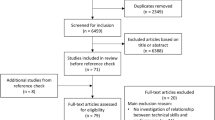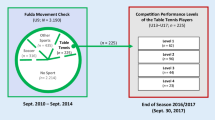Abstract
Several talent-screening programs conducted within elementary schools have implemented motor diagnostics to introduce children to groups of sports including both game and specific sports, the latter of which includes gymnastics, skiing, and tennis. However, as in most other sports, the predictive value for soccer regarding such early testing is unclear. This prospective cohort study evaluated the mid-term prognostic validity of general motor tests as well as a soccer-specific score calculated from a test battery. The sample consisted of N = 2965 U9 age group of children from the Fulda Movement Check (FMC). The FMC is a basic check comprised of two anthropometric parameters and eight general items of the German Motor Test 6–18 by Boes and Schlenker with the addition of a ball throw. The test data were collected from the second grade classes of 2011–2014. The soccer competition performance of those children who chose soccer (n = 316) up to the end of the season 2016/17 (September 30, 2017) was recorded. This group of U12–U15 players was then assigned individually to four different competition levels. The prognostic validity of the motor tests was determined using analysis of variance, odds ratios, and a discriminant analysis. All diagnostic methods exhibited medium to high prognostic validity over the 2‑ to 6‑year time span from the talent screening and talent orientation period to the later soccer competitions in the early adolescent U12–U15 age groups. The prognostic relevance of the nine general motor tests was confirmed.
Zusammenfassung
Üblicherweise nutzen Talentsuchprogramme, die im Grundschulalter durchgeführt werden, motorische Tests, um Kindern eine ihrem Eignungsprofil entsprechende Sportart zu zuzuweisen; darunter fallen beispielsweise Mannschaftssportarten oder Individualsportarten wie Turnen, Skilauf oder Tennis. Hierbei scheint allerdings der Erfolgswert dieser frühen Talentorientierung in den meisten Sportarten – so auch im Fußball – ungeklärt. In der vorliegenden prospektiven Kohortenstudie wurde die mittelfristige prognostische Validität allgemeiner motorischer Tests sowie eines, aus einer Testbatterie abgeleiteten, fußballspezifischen Testwertes untersucht. Die vorliegende Stichprobe besteht aus 2965 Kindern der Altersstufe U9 des Fuldaer Bewegungschecks. Beim Fuldaer Bewegungscheck handelt es sich um eine Testbatterie, bestehend aus zwei anthropometrischen Parametern und acht allgemeinen Bewegungsaufgaben des Deutschen Motorik-Tests 6–18, zusätzlich erweitert um einen Ballweitwurftest. Die Testdaten wurden in den Grundschulklassen der Jahre 2011–2014 erhoben. Für die Studie wurde nachfolgend die Wettkampfleitung zum Ende der Saison 2016/2017 (30. September) derjenigen Kinder betrachtet, die an der Testung teilnahmen und im Nachhinein die Sportart Fußball ausübten (n = 316). Diese Gruppe von Spielern der Altersstufe U12–U15 wurde dann individuell vier verschiedenen Wettbewerbsstufen zugeteilt. Die prognostische Validität des Motoriktests (Fuldaer Bewegungscheck) wurde anhand einer Varianzanalyse, Odds Ratios und einer Diskriminanzanalyse ermittelt. Alle diagnostischen Verfahren zeigten eine mittlere bis hohe prognostische Validität über die Zeitspanne von vier bis sechs Jahren – von der Talentsuche und Talentorientierungsphase bis zu späteren Fußballturnieren in der Altersgruppe der frühen Jugend (U12–U15). Die prognostische Relevanz der neun allgemeinen motorischen Tests wurde somit bestätigt.






Similar content being viewed by others
Notes
Time for a 20 m linear running sprint; measurement by means of light gates (Brower Timing Systems; Draper, UT, USA); error correction of timing was 0.26 s; starting position was 0.3 m behind the start line.
15-s sideward jumping.
3 × 2 trials stepping backward on a 3.0, 4.5 and 6.0 cm wide beam.
Bend forward.
Timed push-ups and sit-ups with number of repetitions within 40 s.
Standing long jump.
6-min run around a volleyball pitch.
Ball weight: 80 g; both feet on ground behind a line; no step or run-up; measurement perpendicular to measuring tape; accuracy: 0.1 m.
GMT in addition to Ball throw; F(3;312) = 12.99; p < 0.001; η2 = 0.111.
F(3;312) = 10.03; p < 0.001; η2 = 0.087.
F(3;312) = 10.02; p < 0.001; η2 = 0.086.
F(3;312) = 6.83; p < 0.001; η2 = 0.061.
F(3;312) = 6.51; p < 0.001; η2 = 0.057.
F(3;312) = 6.00; p < 0.01; η2 = 0.053.
F(3;312) = 4.85; p < 0.01; η2 = 0.044.
F(3;312) = 4.81; p < 0.01; η2 = 0.043.
F(3;312) = 3.74; p < 0.05; η2 = 0.034.
F(3;312) = 2.73; p < 0.05; η2 = 0.025.
F(3;312) = 1.29; p = 0.278.
References
Boes, K., & Schlenker, L. (2016). Der Deutsche Motorik-Test 6–18 (2nd edn.). Hamburg: Feldhaus.
Carling, C., & Collins, D. (2014). Comment on “Football-specific fitness testing: adding value or confirming the evidence?”. Journal of Sports Science, 32(13), 1206–1208.
Carling, C., Le Gall, F., & Malina, R. M. (2012). Body size, skeletal maturity, and functional characteristics of elite academy soccer players on entry between 1992 and 2003. Journal of Sports Sciences, 30(15), 1683–1693. https://doi.org/10.1080/02640414.2011.637950.
Deutscher Fußball-Bund (2009). Talentförderprogramm. Leitfaden für die Ausbildung. Münster: Philippka. Talent development program. Training guideline
Figueiredo, A. J., Gonçalves, C. E., Coelho, E., Silva, M. J., & Malina, R. M. (2009). Youth soccer players. 11–14 years: maturity, size, function, skill and goal orientation. Annals of Human Biology, 36(1), 60–73. https://doi.org/10.1080/03014460802570584.
Fuchslocher, J., Romann, M., Rüdisüli, L. R., Birrer, D., & Hollenstein, C. (2011). Das Talentselektionsinstrument PISTE: wie die Schweiz Nachwuchsathleten auswählt. Leistungssport, 41(4), 22–27.
Le Gall, F., Carling, C., Williams, M., & Reilly, T. (2010). Anthropometric and fitness characteristics of international, professional and amateur male graduate soccer players from an elite youth academy. Journal of Science and Medicine in Sport, 13(1), 90–95.
Golle, K., Muehlbauer, T., Wick, D., & Granacher, U. (2015). Physical fitness percentiles of German children aged 9–12 years: findings from a longitudinal study. PLoS ONE, 10(11), e142393. https://doi.org/10.1371/journal.pone.0142393.
Gonaus, C., & Müller, E. (2012). Using physiological data to predict future career progression in 14- to 17-year-old Austrian soccer academy players. Journal of Sports Sciences, 30(15), 1673–1682. https://doi.org/10.1080/02640414.2012.713980.
Gulbin, J. P., Croser, M. J., Morley, E. J., & Weissensteiner, J. R. (2013). A closer look at the FTEM framework. Response to “More of the same? Comment on ‘An integrated framework for the optimisation of sport and athlete development: a practitioner approach’”. Journal of Sports Sciences, 32(8), 796–800. https://doi.org/10.1080/02640414.2013.855806.
Güllich, A. (2014). Selection, de-selection and progression in German football talent promotion. European Journal of Sport Science, 14(6), 530–537. https://doi.org/10.1080/17461391.2013.858371.
Hohmann, A., & Pietzonka, M. (2017). Techniktraining zur Entwicklung der Spielfähigkeit im Fußball, Handball und Basketball. Köln: Sportverlag Strauss. Technique training to develop play ability in soccer, handball, and basketball
Hohmann, A., & Seidel, I. (2003). Scientific aspects of talent development. International Journal of Physical Education, 40(1), 9–20.
Hohmann, A., Fehr, U., & Voigt, L. (2015). Heute im Talentpool – In Hamburg auf dem Podium. Leistungssport, 45(5), 5–11.
Hohmann, A., Hohmann, L., Scheuring, L., & Zapp, M. (2016). Fuldaer Bewegungs-Check 2010-2015 – Vorläufiger Ergebnisbericht. Bayreuth: Institute of Sport Science. Fulda movement check – preliminary results
Hohmann, A., Fehr, U., Siener, M., & Hochstein, S. (2017a). Talentscreening und Talentorientierung. Leistungssport, 47(4), 11–13.
Hohmann, A., Fehr, U., Siener, M., & Hochstein, S. (2017b). Validity of early talent screening and talent orientation. In P. Platen, A. Ferrauti, E. Grimminger-Seidensticker & T. Jaitner (Eds.), Sport science in a metropolitan area (p. 590). Bochum: University Press.
Höner, O., & Votteler, A. (2016). Prognostic relevance of motor talent predictors in early adolescence: a group- and individual-based evaluation considering different levels of achievement in youth football. Journal of Sports Sciences, 34(24), 2269–2278.
Höner, O., Votteler, A., Schmid, M., Schultz, F., & Roth, K. (2015). Psychometric properties of the motor diagnostics in the German football talent identification and development programme. Journal of Sports Sciences, 33(2), 145–159. https://doi.org/10.1080/02640414.2014.928416.
Höner, O., Leyhr, D., & Kelava, A. (2017). The influence of speed abilities and technical skills in early adolescence on adult success in soccer: a long-term prospective analysis using ANOVA and SEM approaches. PLoS One, 12(8), e182211. https://doi.org/10.1371/journal.pone.0182211.
Lago-Peñas, C., Casais, L., Dellal, A., Rey, E., & Domínguez, E. (2011). Anthropometric and physiological characteristics of young soccer players according to their playing positions: relevance for competition success. Journal of Strength and Conditioning Research/National Strength & Conditioning Association, 25(12), 3358–3367. https://doi.org/10.1519/JSC.0b013e318216305d.
Leite, N., Baker, J., & Sampaio, J. (2009). Paths to expertise in Portuguese national team athletes. Journal of Sports Science and Medicine, 8(4), 560–566.
Lidor, R., Côté, J., & Hackfort, D. (2009). ISSP position stand: to test or not to test? The use of physical skill tests in talent detection and in early phases of sport development. International Journal of Sport and Exercise Psychology, 7(2), 131–146.
Meylan, C., Cronin, J., Oliver, J., & Hughes, M. (2010). Talent identification in soccer: the role of maturity status on physical, physiological and technical characteristics. International Journal of Sports Science & Coaching, 5(4), 571–592.
Mueller, L., Mueller, E., Kornexl, E., & Raschner, C. (2015). The relationship between physical motor skills, gender and relative age effects in young austrian alpine ski racers. International Journal of Sports Science and Coaching, 10(1), 69–86.
Pankhurst, A., & Collins, D. (2013). Talent identification and development: the need for coherence between research, system, and process. Quest, 65(1), 83–97.
Papic, V., Rogulj, N., & Plestina, V. (2009). Identification of sport talents using a web-oriented expert system with a fuzzy module. Expert Systems with Applications, 36, 8830–8838. https://doi.org/10.1016/j.eswa.2008.11.031.
Pion, J. (2015). The Flemish sports compass: from sports orientation to elite performance prediction. Ghent: Ghent University Press.
Pion, J. (2017). Sustainable investment in sports talent: the path to the podium through the school and the sports club. Arnhem: HAN University of Applied Sciences Press.
Pion, J., Hohmann, A., Liu, T., Vandorpe, B., Lenoir, M., & Segers, V. (2016). Predictive models reduce talent development costs in female gymnastics. Journal of Sports Sciences, 35(8), 806–811.
Roescher, C., Elferink-Gemser, M., Huijgen, B., & Visscher, C. (2010). Soccer endurance development in professionals. International Journal of Sports Medicine, 31, 174–179. https://doi.org/10.1055/s-0029-1243254.
Stemper, T., Bachmann, C., Diehlmann, K., & Kemper, B. (2009). Das Düsseldorfer Modell der Bewegungs‑, Sport- und Talentförderung (DüMo). In Bundesinstitut für Sportwissenschaft (Ed.), Talentdiagnose und Talentprognose. 2. BISp-Symposium: Theorie trifft Praxis. (pp. 139–142). Köln: Strauss. The Duesseldorf model of movement, sport and talent promotion.
Willimczik, K. (1982). Determinanten der sportmotorischen Leistungsfähigkeit im Kindesalter. In H. Howald & E. Hahn (Eds.), Kinder im Leistungssport (pp. 141–153). Stuttgart: Birkhäuser. Chapter: determinants of the motor performance at child age. Title: children in elite sport.
Zuber, C., Zibung, M., & Conzelmann, A. (2016). Holistic patterns as an instrument for predicting the performance of promising young soccer players—a 3‑years longitudinal study. Frontiers in Psychology, 7, 1088. https://doi.org/10.3389/fpsyg.2016.01088.
Acknowledgements
This study is part of the research project “talent identification” which was supported by the German Institute of Sport Science (Bonn, Germany). Also, we would like to thank the authorities of the city of Fulda, the Fulda district authorities and the participating elementary schools for supporting the Fulda Movement campaign since 2010.
Author information
Authors and Affiliations
Corresponding author
Ethics declarations
Conflict of interest
A. Hohmann, M. Siener and R. He declare that they have no competing interests.
The author did not conduct any studies with human or animal participants for this article. As for other studies cited in this article, information on ethical guidelines may be found in the respective sources.
Rights and permissions
About this article
Cite this article
Hohmann, A., Siener, M. & He, R. Prognostic validity of talent orientation in soccer. Ger J Exerc Sport Res 48, 478–488 (2018). https://doi.org/10.1007/s12662-018-0549-5
Received:
Accepted:
Published:
Issue Date:
DOI: https://doi.org/10.1007/s12662-018-0549-5




